Are You at Risk of Catching Your Dog’s Parasites?
By Janice Jones |Last Updated 04-08-2021
Discussing those Common Worms in Dogs
and single celled organisms that live in the intestines and hearts of dogs does
not make for polite dinner conversation.
However, if left unchecked, these little creatures can make your dog and
even you very ill and could be potentially deadly.
The most common types of intestinal worms
include
- Roundworms
- Hookworms
- Whipworms
- Tapeworms
- Dogs can also acquire Coccidia and Giardia,
which are single celled organisms. - Heartworms
Examples of Worms in Dogs
Roundworms
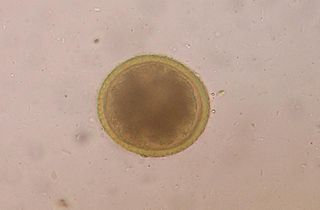 This is a microscopic image of a roundworm egg.
This is a microscopic image of a roundworm egg.The most common form of intestinal parasite is the roundworm. Animals with roundworms pass the infection to others when they shed the worm’s eggs in their stool.
Other animals will eat the infected feces, walk on it and lick their paw, or drink contaminated water. Mothers can pass the infections onto their puppies either before birth or during nursing.
Infected animals can have serious health problems including malnutrition and intestinal issues including diarrhea. Infected animals pose a risk to people because the eggs can be accidentally eaten or enter through the skin.
Children are at greatest risk especially if
they play in areas with infected feces.
If untreated in people, the larval forms can eventually enter organs and
other tissues resulting in damage.
The best way to prevent and treat roundworms is to begin in puppyhood. Puppies should be wormed at 2, 4, 6, and 8 weeks of age and then placed on a heartworm preventative. The heartworm medicine will also control many different intestinal parasites including roundworms.
During the dog’s yearly visit to the veterinarian, a fecal sample can be checked for worms at the same time as the dog is tested for heartworms.
Hookworms
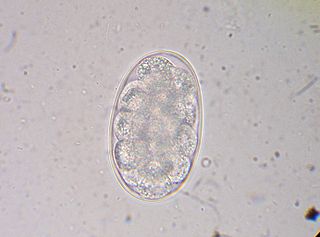 Microscopic photo of a Hookworm egg.
Microscopic photo of a Hookworm egg.Hookworms are also common in dogs and
can be especially dangerous because they bite into the intestinal lining of the
dog and suck blood. If untreated,
hookworm infestations can result in potentially life threatening blood loss,
weakness, and malnutrition.
Sadly,
humans can also be affected when larvae penetrate the skin. If hookworm larvae penetrate the skin they
can cause “cutaneous larval migrans”, a potentially serious and
scarring inflammation results. These infections often occur when people walk barefoot in contaminated areas, or gardening in areas where pets and other dogs have deposited their feces.
The
larvae produce severe itching and tunnel-like red areas as they pass through
the skin. Symptoms that the dog may show include bloody diarrhea, weight loss,
anemia, and progressive weakness.
Whipworms
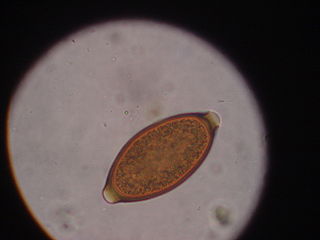 Microscopic Photo of a Whipworm Egg
Microscopic Photo of a Whipworm EggWhipworms pass their eggs in the feces
and other animals become infected by eating infected soil or licking areas of
their bodies that have come into contact with the whipworm eggs.
Whipworms are similar to hookworms in so far
as they bury their heads into the lining of the dog’s intestine and such blood,
but are not as harmful as the hookworm. The
Whipworm lives in the first section of the dog’s large intestine called the
cecum and are often more difficult to detect because they shed few eggs.
Some of the symptoms that a dog with
whipworms may display include chronic weight loss, and feces that seems to have
a light ring of mucus and blood.
You can prevent whipworms by maintaining a strict cleaning schedule. Remove feces from your yard as soon as possible. Don’t neglect the yearly checkup for your dog and collect a stool sample to take along. Many whipworm infections are more difficult to diagnosis and the only way to assure your dog does not have these worms is to have negative fecal test results.
Whipworms
rarely infect humans.
Tapeworms
 Adult Tapeworm Showing Individual Segments
Adult Tapeworm Showing Individual SegmentsThis long flat worm consists of segments that can break off and pass in the dog’s stool. These long flat worms can continue to grow reaching lengths of between six and 24 inches. They attach themselves to the intestines where their egg packets break off and are passed in the feces. This is where you might notice that your dog has tapeworms.
They appear like small grains of rice or seeds. Each little segment has its own reproductive system. You may see these small segments in the dog’s feces or they may stick to the hair around the tail.
There are several types of tapeworms that affect dogs and each one has a different way that can get passed onto the dog. Tapeworms need an intermediary host to complete their life cycle.
For example, Dipylidium caninum is a tapeworm that needs fleas to be passed on whereas other tapeworms must use small animals such as rodents or larger animals such as deer or sheep.
They can also get certain types of tapeworms
by eating infected rodents. They look like flattened grains
of white rice. People do not generally
get dog tapeworms.
The only way to prevent dogs from getting tapeworms is to avoid coming into contact with the intermediary host (fleas or other animals with tapeworm infections)
Flea control is the best way as the most common dog tapeworms use fleas as their intermediary host.
Most tapeworms do not produce severe symptoms in dogs as the other types of intestinal worms. Many people believe that a dog who scoots his rear along the ground is infected with tapeworms. This is not so. Scooting is caused by anal gland problems.
People can get tapeworm infections, but they are rare.
Coccidia
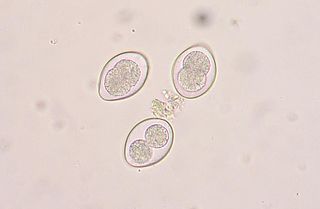 Coccidia oocysts were taken under magnification.
Coccidia oocysts were taken under magnification.Coccidia are single celled parasites
that can only be seen under a microscope.
The dog becomes infected by eating infected soil or licking contaminated
paws or fur.
Once inside the pet,
coccidia damage the lining of the intestine keeping your dog from absorbing nutrients.
Symptoms include watery, bloody diarrhea. Dehydration is also likely. Medicines can be given to prevent the
parasite from multiplying and allow time for your pet’s immune system to kill
the parasite.
Read More about Coccidia in Dogs
Giardia
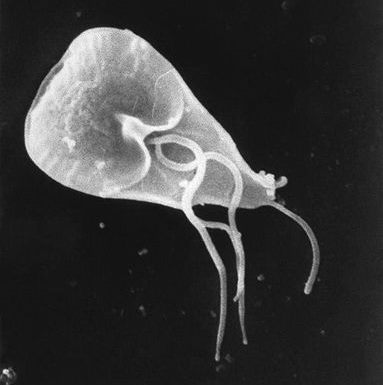 A scanned electron micrograph if Giardia
A scanned electron micrograph if GiardiaGiardia in dogs is another annoying parasite that can
affect your dog’s health. They are not worms in dogs, but small
protozoan, Giardia is not a worm, but a one-celled organism that is also
capable of causing harm in many animals including people, although it’s not
entirely clear how common the transmission is between dogs and people.
Once apart of your environment, its hard to get rid of, but there are treatment options available.
Read more about giardia in dogs.
Heartworms
All of the parasites on this page so far, live in the intestinal tract of your dog. Heartworms, as the name implies, is different. Heartworms live in the dog’s heart and surrounding large blood vessels.
This is a life threatening condition and expensive and difficult to treat. The good news is that it is entirely preventable by giving the dog a once-monthly medication by mouth.
Risk Factors for Common Worms in Dogs
Four scenarios put dogs at risk for worms:
- Newborn
Puppies: Roundworm eggs can form cysts in adult dogs
and that remain dormant. When a
female dog is pregnant, these dormant eggs will activate and infect the
puppies. The mother’s milk can also
pass roundworms to puppies. - Contact with
infected dirt – Roundworm eggs and hookworm larvae can reside in dirt. If you dog runs into infected dirt while
on a walk, at a dog park, or out in the wild, your dog may get worms. - Fleas – Young
tapeworms can reside in fleas. If
your dog swallows fleas while licking a paw or other part of his body, he could
ingest tapeworms and be infected. - Hunting or
eating wildlife – wild animals may carry worms, including tapeworms
residing in fleas on wild animals.
If your dog hunts or eats wildlife, your dog may swallow worms
Diagnosis of Common worms in Dogs
- Intestinal Parasites: A veterinarian can perform a simple
fecal test and prescribe a de-wormer. Most intestinal worms can be detected this way if you bring a fresh fecal sample to your veterinarian. - Tapeworms: You can actually diagnose tapeworms yourself. If you see small segments of the worm in the stool or adhering to the area around the anus. These tiny segments resemble individual grains of rice and are about the same color as white rice.
- Heartworms are diagnosed through a blood test where the vet takes a small sample of blood and uses a test called SNAP test.
- Giardia: Often vets will use a separate test if they suspect giardia because the tiny giardia organisms are more difficult to detect on a typical fecal exam. You will still need to collect a fecal sample
Treatment for Common Worms in Dogs
There are a few medications on the market today that will take care of the parasites in inhabit your dog.
Coccidia
To treat the coccidia organisms, veterinarians will use drugs such as sulfadimethoxine (Albon®) and trimethoprim-sulfadiazine (Tribrissen®)
Toltrazuril, the generic form of the drug Baycox® is also used to treat Coccidia.
Heartworms, Hookworms, Roundworms
Heartgard Plus®
Tri-Heart Plus®
Iverhart Plus®
treats roundworms and hookworms as well as preventing Heartworm. Their main ingredients are ivermectin and pyrantel pamoate.
Roundworms and Hookworms
Drugs such as Nemex-2® contain pyrantel pamoate and treat roundworms and hookworms. This is normally the drug of choice for treating puppies and can be use safely on puppies 2 weeks of age and older.
Strongid® is another drug that uses the generic Pyrantel Pamoate
This is a safe over-the-counter medication that you can purchase on Amazon.
Roundworms, Hookworms, Whipworms, Tapeworms, and Giardia
Drugs such as
Panacur® and Safeguard® are used to treat roundworms, hookworms, whipworms and
tapeworms. Fenbendazole is the generic term for both Panacur and Safeguard.
There is no FDA approval drug for giardia, the diarrhea caused by giardia is often treated by metronidazole under the trade name, Flagyl®.
Panacur Canine Dewormer 1 gram
You do not need a prescription to purchase Panacur.
Tapeworms
Fenbendazole will kill some types of tapeworms but not Dipylidium caninum, the most common dog tapeworm and the one transmitted by fleas. The drug that will kill this type of tapeworm is praziquantel and is sold under the trade name, Droncit®.
Prevention of Common Worms in Dogs
- Keeping fleas away from the dog will
also prevent tapeworm infections. - Do not let your dog roam and hunt; raw
meat, carrion, or parts of dead animals that are likely carriers of parasites. - Keep your grass mowed and pick up
feces frequently. - Keep up to date with monthly heartworm
medication
Yikes, Can I Catch those Worms in Dogs?
If you have ever watched Animal Planet’s “Monsters Inside Me,” you might conclude that every worm possible in our dogs (or cats) are finding their way into our gut or worse. You may also be asking, should I be wormed when my dog is wormed? While it seems strange, this question has been posed by veterinary technicians who work closely with lab samples.
Luckily, the incidence of people getting worms or other parasites is very low. A disease or condition that can be passed between animals and humans is given the term zoonotic. There are a couple of worms that do have zoonotic potential, but again, it is very rare.
Roundworms, Hookworms and Tapeworms have the potential to be passed to people under the right conditions.
Tapeworms
There are a couple of species of tapeworms that can be passed orally to people either by ingesting eggs or consuming vegetation or water contaminated with feces. A different species of tapeworms can be transmitted to people when the eat an infected flea. Most of the time, children are more at risk because they put dirty hands or fingers into their mouth.
Roundworms
Another problematic worm that dogs get can be passed to people. The disease in people, Toxocariasis can occur in two different forms, one that affects the eyes and the other that moves throughout the body.
Ocular Larva Migrans occurs when a microscopic worm enters the eye and causes inflamation and scaring on the retina. it often leads to blindness.
Visceral Larva Migrans occurs when the worms move through out the body’s organs and cause fever, coughing, asthma or pneumonia.
Adults may get these parasites, but children are at greater risk. Children are most likely to get these worms if they play in contaminated dirt, or eat something contaminated with dog feces.
Hookworms
Hookworms are not always passed from dog to person, but rather, people get them through walking on contaminated soil or sand with bare feet. They enter through the skin and cause incredible itching where the worm enters. Other symptoms include diarrhea, weight loss and anemia.
Protect Yourself and Family From These Parasites
To protect yourself and your family
the best preventative is good hygiene, which means:
- Wash hands frequently
- Keep sandboxes covered
- Do not allow children to play in areas likely contaminated
- Wear shoes when outdoors.
- Treat fleas on your dog and your environment
- If you suspect that you or a loved one has become infected, contact your health care provider. DO NOT use veterinary worm medicines
Photographs on this page are courtesy of Creative Commons
Further Reading About Worms in Dogs
Does This Article Deserve Your Thumbs Up?
We always appreciate your support and encouragement. Your thumbs up means so much to us. Please like this article.
If you find this page or any page on Small Dog Place Helpful, or Useful in anyway, I’d love it if you would click the small heart found on the bottom right of each page.
You can also share or bookmark this page — just click on the:


Free Monthly Newsletter
Sign Up for Our Free Newsletter and get our Free Gift to You.
my E-book, The Top 10 Mistakes People Make When Choosing a Dog (and how to avoid them)
If you enjoyed this page, I’d love it if you’d let me know. Just click the button below. Thank you.
Sharing is Caring






